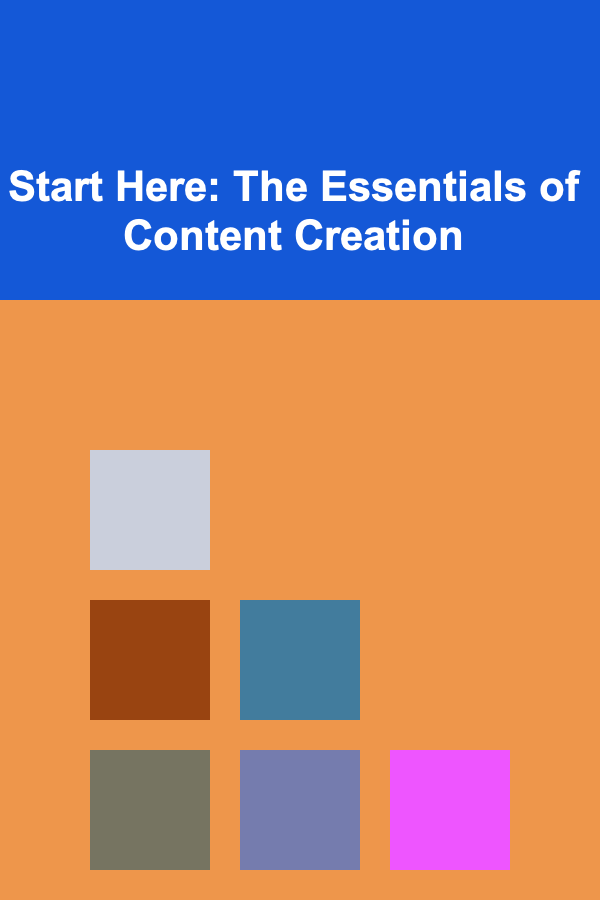
Start Here: The Essentials of Content Creation
ebook include PDF & Audio bundle (Micro Guide)
$12.99$10.99
Limited Time Offer! Order within the next:

Content creation has become an essential skill in today's digital world. Whether you're a marketer, business owner, blogger, or social media influencer, creating high-quality content is the key to engaging with your audience and building a brand. However, with the sheer volume of content being produced every second, standing out and making an impact can be a challenge.
This guide will walk you through the essential elements of content creation---offering practical advice, tips, and actionable steps to help you produce content that not only attracts but also engages and converts your audience.
Understanding Your Audience
Before you even start creating content, you need to have a deep understanding of who your audience is. Content creation isn't about creating something that you find interesting or fun; it's about creating something that resonates with your target audience.
Who Are They?
To tailor your content, start by identifying your ideal audience. What are their pain points? What do they value? What questions do they have that your content can answer? The more specific you can get about your audience, the more targeted your content will be.
Here are some key aspects to consider:
- Demographics: Age, gender, occupation, location, etc.
- Psychographics: Values, interests, lifestyle, and behavior patterns.
- Pain Points: What problems does your audience need solutions for?
- Goals and Desires: What do they want to achieve? This can be related to their career, personal growth, or lifestyle.
Creating Audience Personas
One effective method to better understand your audience is to create audience personas. These are fictional characters that represent the different segments of your audience. Each persona should detail aspects like:
- Name, age, and background.
- Job, challenges, and goals.
- How they consume content (social media, blog posts, podcasts, etc.).
- Their preferred content formats (videos, infographics, written content).
Once you have personas in mind, it will become much easier to create content that speaks directly to them.
Setting Clear Content Goals
Every piece of content you create should have a specific goal. Without a clear objective, your content is likely to miss the mark, wasting both time and effort. These goals should align with your overall business or personal objectives.
Common Content Goals
- Brand Awareness: Content that introduces your brand, educates your audience, and builds trust.
- Lead Generation: Content that encourages your audience to take action, like signing up for a newsletter or downloading an eBook.
- Sales and Conversions: Content designed to move potential customers through your sales funnel and convince them to purchase or take a specific action.
- Engagement: Content aimed at fostering community interaction, like social media posts, polls, or discussions.
- Customer Retention: Content that maintains customer interest and loyalty, such as follow-up emails, exclusive offers, or loyalty programs.
Once your content goals are defined, you can begin crafting your message and determining the format that best suits your objective. Keep in mind that content goals may vary based on the type of content, platform, or stage in the buyer's journey.
Creating High-Quality Content
Quality is king in the world of content creation. Whether it's blog posts, videos, or social media posts, creating content that's valuable, well-written, and well-produced will set you apart from the competition.
Writing for the Web
Writing for the web is different from traditional writing. Online readers tend to skim content, so it's essential to make your content scannable and engaging from the start.
Here are some best practices for writing compelling online content:
- Start with a Hook: Your first sentence should grab attention. Use intriguing questions, shocking statistics, or bold statements to make the reader want to continue.
- Short Paragraphs and Sentences: Online readers prefer short, easy-to-digest content. Break your text into manageable chunks to make it more reader-friendly.
- Headings and Subheadings: Use headings to guide readers through the content. Subheadings help highlight key points and provide structure.
- Call-to-Action (CTA): Every piece of content should have a clear CTA, telling the reader what you want them to do next---whether it's signing up for a newsletter, watching a video, or making a purchase.
Visual Content Matters
While the written word is powerful, visuals play an equally important role in engaging your audience. In fact, the human brain processes images 60,000 times faster than text, which means adding visuals to your content is crucial for capturing attention.
Here are some visual elements you should consider incorporating:
- Images: High-quality photos, illustrations, or graphics can enhance the aesthetic appeal of your content and help illustrate your points.
- Videos: Videos are incredibly engaging and effective for demonstrating products, sharing stories, or explaining complex concepts.
- Infographics: These are highly shareable and great for breaking down complex information into digestible, visually appealing formats.
- Charts and Graphs: Use data visualizations to make statistics easier to understand and more engaging.
Consistency in Tone and Style
Your content should reflect a consistent tone and style that resonates with your audience. If your brand voice is playful and casual, keep that tone throughout all your content. If you're targeting professionals, a more formal and authoritative voice may be appropriate.
Consistency in style doesn't only refer to language---it also includes the design elements of your content, such as fonts, colors, and formatting. A unified visual identity helps build brand recognition and trust.
Optimizing Content for SEO
Creating high-quality content is only half the battle. To ensure your content gets discovered, you must optimize it for search engines. SEO (Search Engine Optimization) is the practice of improving the visibility of your content in search engine results, so more people can find it.
Keyword Research
Start by identifying the keywords your target audience is searching for. Use tools like Google Keyword Planner, SEMrush, or Ubersuggest to find high-traffic keywords relevant to your content.
On-Page SEO
Here are some basic on-page SEO practices to ensure your content is search engine-friendly:
- Title Tag: Ensure your title contains the main keyword, and make it compelling enough to encourage clicks.
- Meta Description: This is the brief text that appears under your title in search results. Write a clear, engaging description that encourages people to click through.
- Header Tags: Use header tags (H1, H2, H3) to structure your content logically and make it more readable.
- Internal and External Links: Link to other relevant content on your site to keep readers engaged. Also, link to authoritative external sources to add value and credibility to your content.
Mobile Optimization
With mobile traffic surpassing desktop, it's crucial that your content is optimized for mobile devices. Ensure that your website is mobile-friendly and that your content is easy to read on smaller screens.
Promoting Your Content
Creating amazing content is just the beginning---promoting it is where the magic happens. Without promotion, even the best content can go unnoticed.
Leverage Social Media
Promote your content across your social media platforms. Share snippets, quotes, or key takeaways that will entice your followers to visit your website or read your blog post. Tailor your posts to each platform:
- Instagram: Use visuals and stories to share highlights from your content.
- Twitter: Share bite-sized information and link to your full content.
- Facebook: Post links, images, or videos with a compelling caption to encourage clicks.
- LinkedIn: Publish professional articles and share industry insights that lead back to your website.
Email Marketing
Build an email list and send your subscribers regular updates. Share valuable content, behind-the-scenes glimpses, and exclusive offers to keep them engaged and coming back for more.
Influencer Marketing
Collaborate with influencers in your niche who can amplify your content to their followers. Partnering with influencers who share your target audience can significantly boost your reach.
Paid Advertising
Consider using paid advertising on platforms like Google Ads or social media to promote your content. Well-targeted ads can drive high-quality traffic to your content, increasing its visibility and helping you achieve your goals.
Measuring and Improving Content Performance
Creating content is an ongoing process, and measuring its performance is key to continuous improvement. Tools like Google Analytics, social media insights, and content management platforms can help you track how your content is performing.
Key Metrics to Track
- Traffic: How many people are visiting your content? Where is the traffic coming from (organic, social, referral)?
- Engagement: Are people interacting with your content? Look at comments, likes, shares, and time spent on the page.
- Conversions: Are you meeting your content goals? Track how many visitors are taking the desired actions (sign-ups, purchases, etc.).
- Bounce Rate: This indicates how many visitors leave your page without interacting. A high bounce rate might signal that your content isn't engaging enough.
Iterate and Improve
Use the insights you gather to continuously improve your content. Test different formats, headlines, or CTAs to see what works best for your audience. Content creation is an ongoing cycle of learning, adapting, and evolving.
Conclusion
Content creation is more than just putting words on a page or posting images online. It's about crafting content that resonates with your audience, solves their problems, and helps them achieve their goals. By understanding your audience, setting clear objectives, creating high-quality content, optimizing for SEO, promoting your work, and measuring performance, you'll be well on your way to content creation success.
Consistency, quality, and value are the keys to building a loyal audience and establishing a lasting presence in your industry. So, start creating, and keep refining your craft as you go!

How to Decorate for Christmas with an Eco-Friendly Approach
Read More
How to Incorporate Whole Foods into Your Meal Prep
Read More
How to Keep Your Entryway Tidy and Space-Saving
Read More
How to Organize Essential Oils for DIY Projects
Read More
How to Use AI Chatbots to Make Money
Read More
Stand Out with Social Media: How to Build a Memorable Online Presence
Read MoreOther Products

How to Decorate for Christmas with an Eco-Friendly Approach
Read More
How to Incorporate Whole Foods into Your Meal Prep
Read More
How to Keep Your Entryway Tidy and Space-Saving
Read More
How to Organize Essential Oils for DIY Projects
Read More
How to Use AI Chatbots to Make Money
Read More